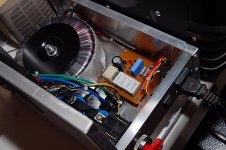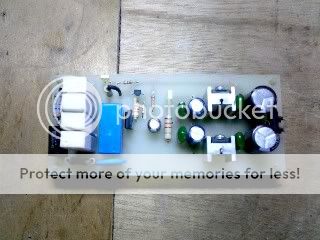Is there evidence that high value wire wounds can tolerate similar overloads, as can low value wire wounds?
The amount of current is divided into four for a 4-parallel resistor arrangement. At least that's what the numbers are telling me.
I put enormous short term currents through 10r or 20r 5W resistors, way above the continuous current rating. So far I have not seen unreliablity.
I have done the same with 600mW metal film.
They don't tolerate overload.
Values change, colours change, or they act like a 20second fuse fuming and sparking as they fail.
I have yet to try that intentionally. Time to put out some wire wounds.
there is really no need to make a big deal out of a circuit that will only need about 3 seconds to do its job...
a lot shorter in my amps...
your amp doesn't determine timing
As noted above I think it wouldn't be hard to have a board that could accommodate parallel resistors or series NTCs (2).
However, to do that, the resistors also needs to be in a series arrangement.
As noted above I think it wouldn't be hard to have a board that could accommodate parallel resistors or series NTCs (2).
Last edited:
a lot shorter in my amps...
yes, so why belabor the resistor value? series/parallel, who cares? as long as the circuit do the job...
i have built a lot of amps without even using a soft starter, i used a big current rated switch, rated for 16 amperes....
I'd just like to point out that reconstructing the board to take parallel resistors or two series NTC (or just one) would not be hard.
You can do that now with the existing boards, parallel resistors or a single NTC.
your amp doesn't determine timing
Of course not.
your amp doesn't determine timing
yes of course, it is the rc time constant that does...
if your soft start resistors burn out, that means you were doing something wrong to begin with...
yes, so why belabor the resistor value? series/parallel, who cares? as long as the circuit do the job...
i have built a lot of amps without even using a soft starter, i used a big current rated switch, rated for 16 amperes....
Since I got the chance to use toroids and the price of capacitance dropped I'd rather stick one in an amp.
You can do that now with the existing boards, parallel resistors or a single NTC.
Andrew has pointed out that a couple of NTCs in series may be preferred/needed in some situations
Andrew has pointed out that a couple of NTCs in series may be preferred/needed in some situations
with NTC's? nah, i wouldn't do that at all....
Andrew has pointed out that a couple of NTCs in series may be preferred/needed in some situations
That however is something you cannot "officially" do with the existing boards, however, as diyers, you can always connect and solder two leads of two NTCs and then solder the other two leads to the board. Some heatshrink wraps should do nicely.
Agreed. I also suspect there's no need in most situations for there to be two in series - just have the switch flick before the rating of the NTC is exceeded.
I'm still interested in why Andrew is pressing for series rather than parallel resistors...the desire to use NTCs rather than resistors doesn't demand the resistors be in series also.
I need to read the passages Mark alluded to in post #176
I'm still interested in why Andrew is pressing for series rather than parallel resistors...the desire to use NTCs rather than resistors doesn't demand the resistors be in series also.
I need to read the passages Mark alluded to in post #176
Last edited:
Agreed. I also suspect there's no need in most situations for there to be two in series - just have the switch flick before the rating of the NTC is exceeded.
Perhaps but many years ago, I built an F1 with crazy amounts of capacitance and used a single CL-60 in the primary. The slow blow fuse kept on blowing up upon power up so we end up using two CL-60 in series.
I'm still interested in why Andrew is pressing for series rather than parallel resistors...the desire to use NTCs rather than resistors doesn't demand the resistors be in series also.
Me too. In the hopes of making a better, easy to build soft start.
I did make one with comparators, timers, etc but it has proven to be far more complicated and I assume it would be also for someone else to build. I think Andrew has commented before regarding control of the timing which will be better having it's own "real" timer. But KISS principle tend to be against it.
This soft start has so far worked with amps I use everyday, I also use an early prototype on my cnc psu because of the large toroid and amount of capacitance I used.
Attachments
But KISS principle tend to be against it.
yes, the simpler the better...
Yet the circuit has a readily controllable "timer" - set to taste using C2 and/or the current limiting LED resistor.
I note that Self says to NOT place resistors in series: "with a parallel connection, if one of the resistors fails open-circuit (which is by far the most likely mode), the inrush system will probably keep working satisfactorily."
I note that Self says to NOT place resistors in series: "with a parallel connection, if one of the resistors fails open-circuit (which is by far the most likely mode), the inrush system will probably keep working satisfactorily."
i leave them in my circuit,(not short them out)....and so far no failures...
At least in my project it's a very good idea to have them switched out. Furthermore, switching them out increases the chances they cool ahead of a 'hot start'.
Yet the circuit has a readily controllable "timer" - set to taste using C2 and/or the current limiting LED resistor.
Indeed. I use a large 1uf cap for C2 and just tailor fit. This is especially useful for me when using different brands of relays.
I note that Self says to NOT place resistors in series: "with a parallel connection, if one of the resistors fails open-circuit (which is by far the most likely mode), the inrush system will probably keep working satisfactorily."
That is also a good point but I'm keeping an open mind on the idea of series resistors too. Especially in the are of reliability.
yes, the simpler the better...
otoh, KISS goes against the "because we can" diyer's code.
- Home
- Amplifiers
- Power Supplies
- Soft start circuit design and other psu issues

